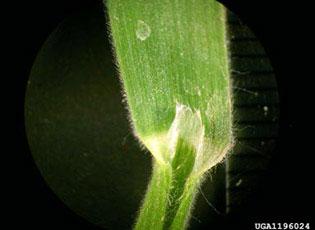Bromus tectorum L. (ITIS)
Downy brome, bronco grass, downy chess, drooping brome, June grass, early chess, military chess, cheatgrass
Eurasia (Bartlett et al. 2002)
1800s (Bartlett et al. 2002)
Introduced accidentally as a seed contaminant (Bartlett et al. 2002)
Crowds out native grasses (Mosley et al. 1999); creates wildfire hazards (Colorado State Parks 2005)

Cheatgrass, features; ligule
Photo by Fred Fishel; University of Missouri
Find more images
Spotlights
Distribution / Maps / Survey Status
All Resources
Selected Resources
The section below contains highly relevant resources for this species, organized by source.
Council or Task Force
Partnership
Federal Government
International Government
State and Local Government
Bartlett, E., S.J. Novak, and R.N. Mack. 2002. Genetic variation in Bromus tectorum (Poaceae): differentiation in the eastern United States. American Journal of Botany 89(4):602-612.
Colorado State Parks. 2005. Downy Brome (Cheatgrass) - Best Management Practices - Weed Profile [PDF, 214 KB].
Integrated Taxonomic Information System. Bromus tectorum. [Accessed Aug 27, 2023].
Mosely, J.C., S.C. Bunting, and M.E. Monoukian. 1999. Cheatgrass. In: R.L. Sheley and J.K. Petrof (Eds.), Biology and Management of Noxious Rangeland Weeds. Corvallis, OR: Oregon State University Press.
